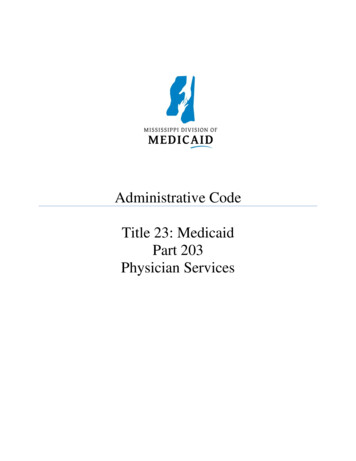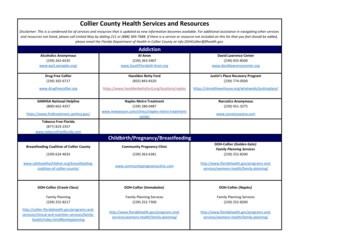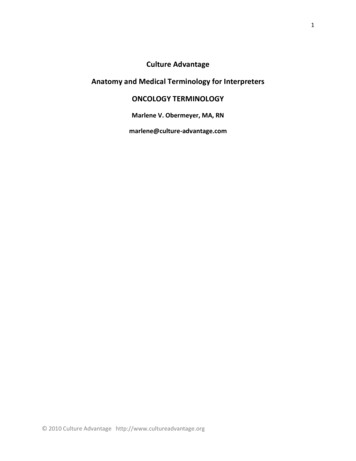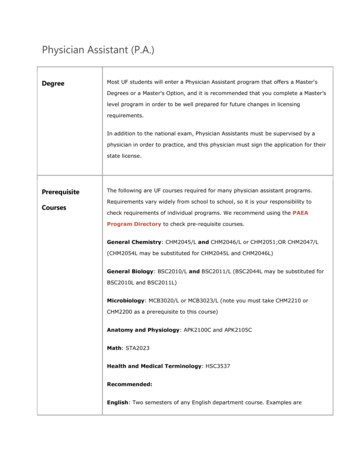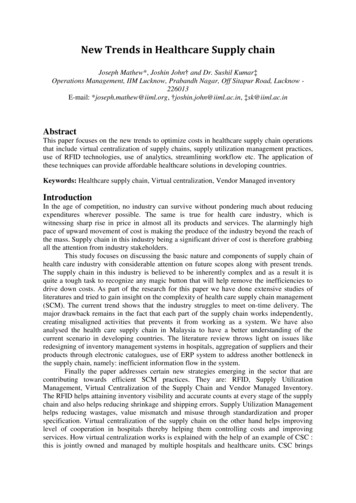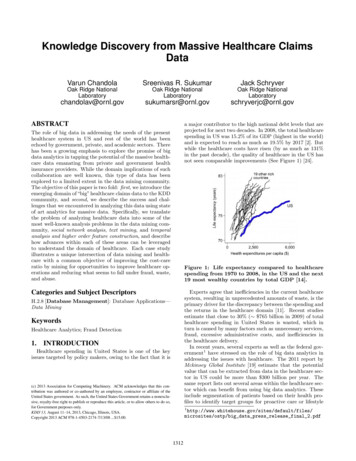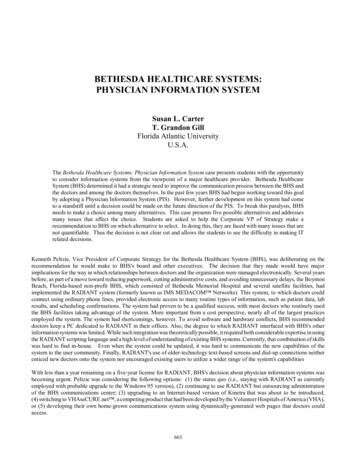
Transcription
BETHESDA HEALTHCARE SYSTEMS:PHYSICIAN INFORMATION SYSTEMSusan L. CarterT. Grandon GillFlorida Atlantic UniversityU.S.A.The Bethesda Healthcare Systems: Physician Information System case presents students with the opportunityto consider information systems from the viewpoint of a major healthcare provider. Bethesda HealthcareSystem (BHS) determined it had a strategic need to improve the communication process between the BHS andthe doctors and among the doctors themselves. In the past few years BHS had begun working toward this goalby adopting a Physician Information System (PIS). However, further development on this system had cometo a standstill until a decision could be made on the future direction of the PIS. To break this paralysis, BHSneeds to make a choice among many alternatives. This case presents five possible alternatives and addressesmany issues that affect the choice. Students are asked to help the Corporate VP of Strategy make arecommendation to BHS on which alternative to select. In doing this, they are faced with many issues that arenot quantifiable. Thus the decision is not clear cut and allows the students to see the difficulty in making ITrelated decisions.Kenneth Peltzie, Vice President of Corporate Strategy for the Bethesda Healthcare System (BHS), was deliberating on therecommendation he would make to BHS's board and other executives. The decision that they made would have majorimplications for the way in which relationships between doctors and the organization were managed electronically. Several yearsbefore, as part of a move toward reducing paperwork, cutting administrative costs, and avoiding unnecessary delays, the BoyntonBeach, Florida-based non-profit BHS, which consisted of Bethesda Memorial Hospital and several satellite facilities, hadimplemented the RADIANT system (formerly known as IMS MEDACOM Networks). This system, to which doctors couldconnect using ordinary phone lines, provided electronic access to many routine types of information, such as patient data, labresults, and scheduling confirmations. The system had proven to be a qualified success, with most doctors who routinely usedthe BHS facilities taking advantage of the system. More important from a cost perspective, nearly all of the largest practicesemployed the system. The system had shortcomings, however. To avoid software and hardware conflicts, BHS recommendeddoctors keep a PC dedicated to RADIANT in their offices. Also, the degree to which RADIANT interfaced with BHS's otherinformation systems was limited. While such integration was theoretically possible, it required both considerable expertise in usingthe RADIANT scripting language and a high level of understanding of existing BHS systems. Currently, that combination of skillswas hard to find in-house. Even when the system could be updated, it was hard to communicate the new capabilities of thesystem to the user community. Finally, RADIANT's use of older-technology text-based screens and dial-up connections neitherenticed new doctors onto the system nor encouraged existing users to utilize a wider range of the system's capabilitiesWith less than a year remaining on a five-year license for RADIANT, BHS's decision about physician information systems wasbecoming urgent. Peltzie was considering the following options: (1) the status quo (i.e., staying with RADIANT as currentlyemployed with probable upgrade to the Windows 95 version), (2) continuing to use RADIANT but outsourcing administrationof the BHS communications center; (3) upgrading to an Internet-based version of Kinetra that was about to be introduced,(4) switching to VHAseCURE.net , a competing product that had been developed by the Volunteer Hospitals of America (VHA),or (5) developing their own home-grown communications system using dynamically-generated web pages that doctors couldaccess.663
Carter and GillNo matter what decision was made on the physician information system, it would ultimately have a major impact on his goal oftransforming BHS into a paperless organization. Thus, the decision on how best to accomplish electronic integration of doctors'offices with BHS needed to be made in concert with the organization's overall strategy.HEALTH CARE INDUSTRYMany players make up the healthcare industry: patients, payers (patients, insurance companies, government), and providers(doctors, hospitals) of health-related services. Prior to the 1980s, patients were viewed as both consumers, of services andcustomers buying services. As consumers when they needed care they went to a provider of their choice. Insurance companiesthen acted in the role of payer, taking care of a prespecified percentage of patient costs. In the 1970s, a movement toward“managed care” grew out of a concern for cost containment. Managed care led to new types of health insurance organizations,including preferred provider organizations (PPOs) and health maintenance organizations (HMOs) where the employers were thecustomers. In addition, the period from the 1960s to the 1990s saw a huge increase in government-sponsored healthcareprograms, primarily Medicare and Medicaid. While some traditional insurance plans still existed, paying a set percentage of costsno matter what health-related service providers were used, PPOs and HMOs (and, to a lesser extent, government programs)provided agreements with specific providers and limited their insured to seeing only those providers. When non-designatedproviders were used, companies either refused to reimburse patients or extracted heavy penalties.With the growth of managed care, the process of supplying health-related services became increasingly complex. Not only didpatients have to utilize designated providers (who typically had contracts with more than one managed care organization), butthey also had to follow plan guidelines with respect to covered services. Some companies, for example, actively promotedambulatory care. Ambulatory care took patients out of the in-patient status in the hospitals and put them in outpatient facilitiesrun by the hospitals or separate organizations. As a result, procedures formerly done in the hospital now had to be done in nonhospital settings to qualify for full reimbursement. Managed care organizations were not only selling insurance, but effectivelycontrolling the type and quantity of care given. In some cases, the decision about what constituted appropriate care was takentotally out of the doctors' hands. For example, the length of a hospital stay for certain medical events (such as childbirth) was setby the provider, not the doctor. Not only did this take the decisions away from the doctors, it also caused a public outcry. Asa result, the government increasingly became involved in the healthcare industry in another role—that of a regulator.The dynamic nature of the healthcare industry meant that suppliers of healthcare services needed to be extremely adaptable tosurvive. They had to be able to customize their billing to the procedures of each different payer. They had to be able to changerapidly as each payer changed. They had to keep current with new medical technologies and procedures—and the rules governingthe uses of the technologies and procedures, which changed daily. And, of course, they had to do their best to improve thecondition of their patients.HospitalsHospitals are the most complex health service providers. Hospitals are characterized by a complicated organizational structure,an extensive division of labor, and an elaborate system of coordination of tasks, functions, and social interaction. They arecomprised of many departments such as emergency services, surgical services, imaging services, and maternity services, to namejust a few. Authority in the typical hospital is shared by a triad: the board of trustees, doctors, and administrators. This sharingtypically leads to a delicate balance of power between the factions, which is in turn influenced by other factors, such as hospitalownership (e.g., profit vs. non-profit, secular vs. church-affiliated, public vs. private, independent vs. part of a chain).Because hospitals are extremely dependent on the community they serve, there is no such thing as a “standard” hospitalorganization. Common to most hospitals, however, is an extensive division of labor. Paradoxically, while many of activitiesperformed in a hospital are highly departmentalized and specialized, they are nonetheless highly interdependent. Nearly all ofthe activities that affect the well being of a patient interact with each other. To further complicate matters, the hospital has littlecontrol over its workload or over its patients. The flow of work is variable and irregular, so coordination through mechanical664
Teaching Case: Bethesda Healthcare Systemsstandardization—as is done in a typical assembly line—is not possible. As a result, a great need for intercommunication amongtask specialties exists.1One major challenge to management is that hospitals typically have little control over some of their key players—most notably,doctors. Doctors play a pivotal role since hospitals only provide the services ordered by the doctors. Most doctors, however, arenot employees of the hospital. Instead they have privileges with the hospital, which means they may order services. In effect,hospitals provide a work place for the doctors and staff who provide the services. In turn, the hospital has several mainresponsibilities: first, to provide the services properly; second, to facilitate the providing of the services; and third, to investigateand handle matters if a doctor makes a mistake. For example, doctors need to be able to access all available existing data abouta patient in order to make the best decision as to which procedure to order. The hospital has to be in a position to supply such data.Hospital revenues come primarily from payments from insurance, the government, and patients (although donations may also playa role in non-profit or church-affiliated hospitals). Rather than being paid based on actual charges for services, today’s hospitalsusually are paid based on diagnosis, average per diem, or a percentage of the charge. Unfortunately, there is virtually no agreementacross different payers regarding what fees are appropriate for a given circumstance.Information Systems in the Healthcare IndustryPrior to the mid-1970s, the expense and complexity of computer technology made it impractical for all but the largest hospitalsto own their own computers. Most hospitals, therefore, had to rely on paper-based information systems, sometimes supplementedby terminals supplied by vendors, such as American Hospital Supply Co. During the decade that followed, technology prices andthe advent of PCs and networks led to a rapid automation of hospital core applications (patient accounting, general accounting,and order entry). By the late 1980s, however, few straightforward automation opportunities remained. Hospitals then turned theirattention to more complex applications, including clinical systems, systems to aid in the care of the patients such as clinicaldecision support systems and computer-assisted patient care. Such clinical systems, however, could not work in isolation. Instead,they needed to be integrated with the existing administrative and financial systems.An approach used to achieve such integration was the development of Clinical Data Repositories (CDR), a.k.a. Clinical DataRecord. Such CDRs were, effectively, central databases of information that could be accessed by many different systems. Onetype of CDR, for example, contained the information, primarily administrative, related to the hospital patient record. By the late1990s, this type of CDR could display patient-related data, but was limited in its ability to provide comparative data andmanipulate that data. A more ambitious CDR held an interactive medical record. Ultimately, this type of CDR was intended tofully automate the patient’s medical record, allowing information such as digitized x-rays, EKG readouts, and scanned paperdocuments to be attached—although few systems had incorporated all if these capabilities by the late 1990s. In the past, vendorshad developed these two types of systems independent of each other. At the time of the case, however, hospitals were placingincreased pressure on vendors to merge the two types of CDR. At the same time, concerns existed regarding inadequate responsetimes, lack of physician input into their design, questions of data ownership and security, and the failure of vendors to demonstratea fully operational installed system.2The transition in healthcare information systems usage occurred during a period of turmoil among the suppliers of these systems.In period between 1995 and 1997, for example, over 1,500 applications became obsolete as a result of vendor acquisitions ofcompetitive products. In addition, even if a product was not eliminated as a result of a competitive acquisition, the acquiringcompany often decided to cut back on new system development—effectively eliminating the product’s long-term viability. Asa result, healthcare enterprises were routinely required to expend resources to acquire replacement systems. Another major changeleading to the replacement of existing systems was the emergence of the Internet and the use of intranets (internal networks thatutilized Internet protocols and software). These communications technologies served to redefine the “healthcare competitive1Source: Kurt Darr and Jonathon S. Rakich, Hospital Organization and Management Text and Readings, National Health Publishing 1989,pp. 22-33.2Source: Ronald Johnson, Session 34: Trends in Health Care and Health Care Systems, The Healthcare Information and Management SystemsSociety, 1998.665
Carter and Gilllandscape to link healthcare practice, management and automation in a new model of Internet team medicine.”3 The Internet, withits widespread availability and easy access, made communication among users cheaper and, more importantly, much moreconvenient. Regional healthcare organizations in particular found that they no longer had to design and maintain their own widearea networks to establish communication between members.A final challenge to implementing healthcare information systems—particularly clinical systems—was long standing in nature:gaining acceptance by the doctors and other healthcare providers who must use them. Since the first computer appeared in ahospital, resistance from users had been commonplace. In some cases such resistance stemmed from general discomfort withinformation technology. More often, however, it was a result of new systems requiring that changes be made in “the ways they[doctors] have traditionally recorded, retrieved, and utilized clinical data.”4 Because of the complex managerial relationships inhospitals and healthcare enterprises, it was nearly impossible to force doctors to accept a new system. Only substantial benefits(to the doctor) from using the system, coupled with widespread acceptance by peers, could serve to motivate doctors to make therequired change.BETHESDA HEALTHCARE SYSTEMBethesda Healthcare System was located in Boynton Beach on the Gold Coast of Florida, a region of rapid growth. Because ofthis rapid growth, and because of a large retired population with an above-average requirement for medical services, the need formedical care in the region had grown dramatically since the 1960s, with no end to growth in sight. Where once a few isolatedhospitals existed, many hospital groups were established, the majority of which offered services at more than one physicallocation.BackgroundIn 1959, Bethesda Memorial Hospital opened its doors and began serving the Southeastern Palm Beach County Hospital Districtas a tax-assisted entity. To enhance its competitive posture, in the mid-1980s the hospital was restructured as a private, not-forprofit corporation known as Bethesda Healthcare System (BHS). This new corporation managed all of Bethesda’s services. Overthe years, to keep up with the needs of the community, Bethesda Healthcare System grew and, by the late 1990s, includedBethesda Memorial Hospital, Bethesda Health City, Bethesda Women’s Health Center, and Bethesda Professional Plaza. Thesefacilities were in multiple locations throughout the city of Boynton Beach, Florida.Bethesda Memorial Hospital (BMH) was a fully accredited private community-based hospital offering a full array of healthcareservices. More than 400 physicians, representing over 30 areas of specialty, were affiliated with the hospital. One of a numberof satellite facilities, Bethesda Health City offered “the convenience of a mall setting with family doctors, specialists, andhealthcare professionals working together in one location” according to the hospital’s web page. It offered a variety of servicesunder one roof so patients did not have to travel from place to place. Bethesda Women’s Health Center specialized in treating thephysical, emotional and social aspects of healthcare for women of all ages. Bethesda Fitness Center, in addition to being a gym,provided physical therapy and assisted patients with recovery and rehabilitation. Bethesda Professional Plaza was an officecomplex primarily intended to house medical professionals in a variety of specialties. (See Exhibit 1 for a list of services.)Exhibits 2 presents the organization charts for BHS.BHS was a member of the Voluntary Hospitals of America (VHA), a nationwide network of community-owned healthcareorganizations and physicians. Among the functions the VHA performs for its members are consolidated purchasing andinformation transfer, allowing smaller community hospitals to mimic the buying power of their larger urban cousins.3Source: Steve Fink and Gary Gorden, Session 23: Healthcare and the Internet: Using Internet Technology to Create CompetitiveAdvantage, The Healthcare Information and Management Systems Society, 1997.4Source: James G. Anderson, “Clearing the Way for Physicians’ Use of Clinical Information Systems,” Communications of the ACM, August1997, pp. 83-90.666
Teaching Case: Bethesda Healthcare SystemsIS DepartmentThe 36 IS employees at BHS were divided into three groups, with about equal numbers in each. Its Technical Services group wasresponsible for PC support, all hardware and software maintenance throughout the facility, and network and databaseadministration. The Operations group kept the mainframe running 24 hours a day, seven days a week. The third group, theAnalysts, developed the applications, built screens, and generally supported the customers with application problems. Applicationsincluded but were not limited to financial, administrative, and clinical systems. BHS customized SMS-supplied software to meetits clinical needs. Among the modules used by BHS were On-line Patient Care Documentation (PCD), Order Processing, andLifetime Clinical Record (LCR). The nurses used PCD for charting the plan of care for a patient, assessments of the patient, andthe patient’s vital signs. The Order Processing system was used by the unit clerks and the nurses to enter doctors’ orders, whichwere then sent to the ancillary departments (such as Radiology). Once the orders were carried out, the results were put back intothe system.One major challenge that BHS faced was making the Lifetime Clinical Record (LCR) electronically accessible to the doctors.At present, the physicians had to print out anything they wanted. IS wanted to provide better access for the physicians, primarilythrough the development of the Physician’s View. The Physician’s View would be the doctors’ equivalent to the nurses’ PCD.Eventually, the Physician’s View would provide the physicians with the ability to place orders, look up results of tests on-line,etc. BMS’s Information System’s director, Leslie Durham, stated that one major goal was to make these systems interdisciplinary.At present, many departments such a
Teaching Case: Bethesda Healthcare Systems 1Source: Kurt Darr and Jonathon S. Rakich, Hospital Organization and Management Text and Readings, National Health Publishing 1989, pp. 22-33. 2Source: Ronald Johnson, Session 34: Trends in Health Care and Health Care Systems, The Healthcare Information and M
